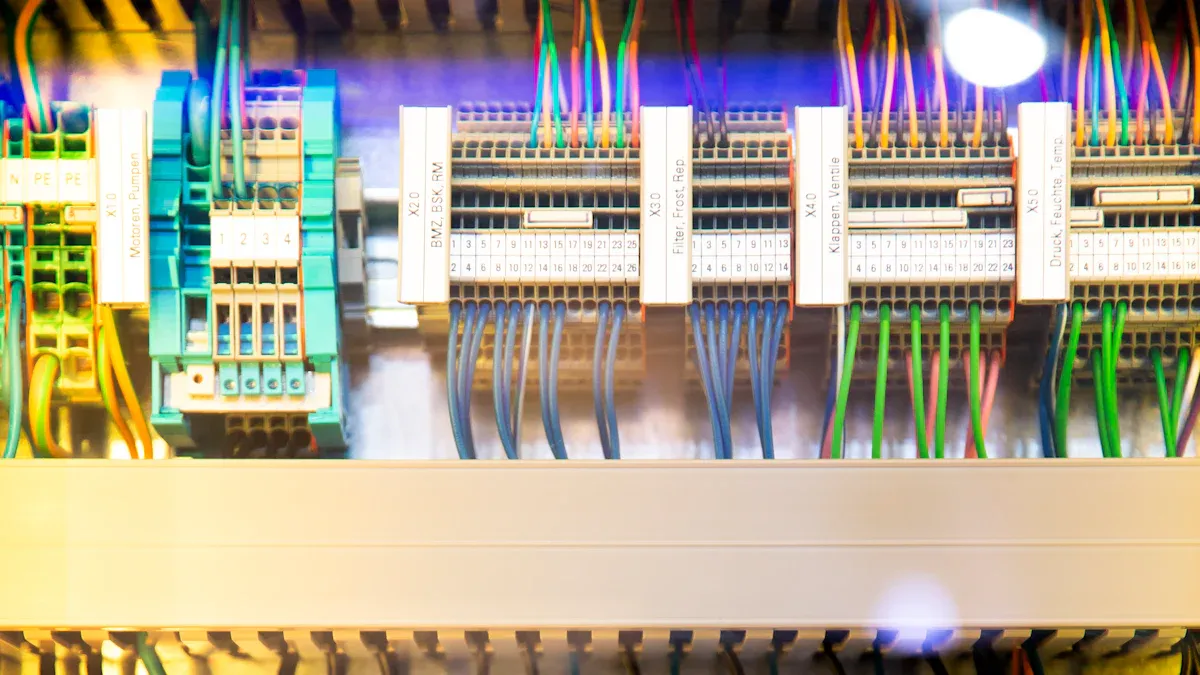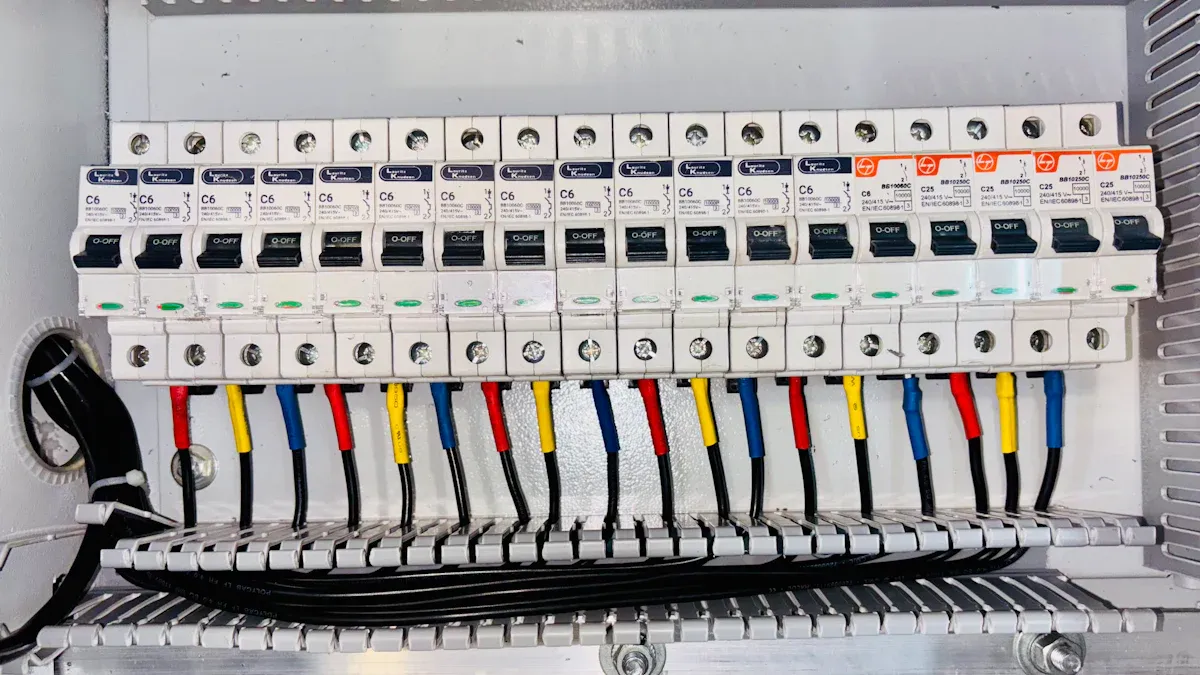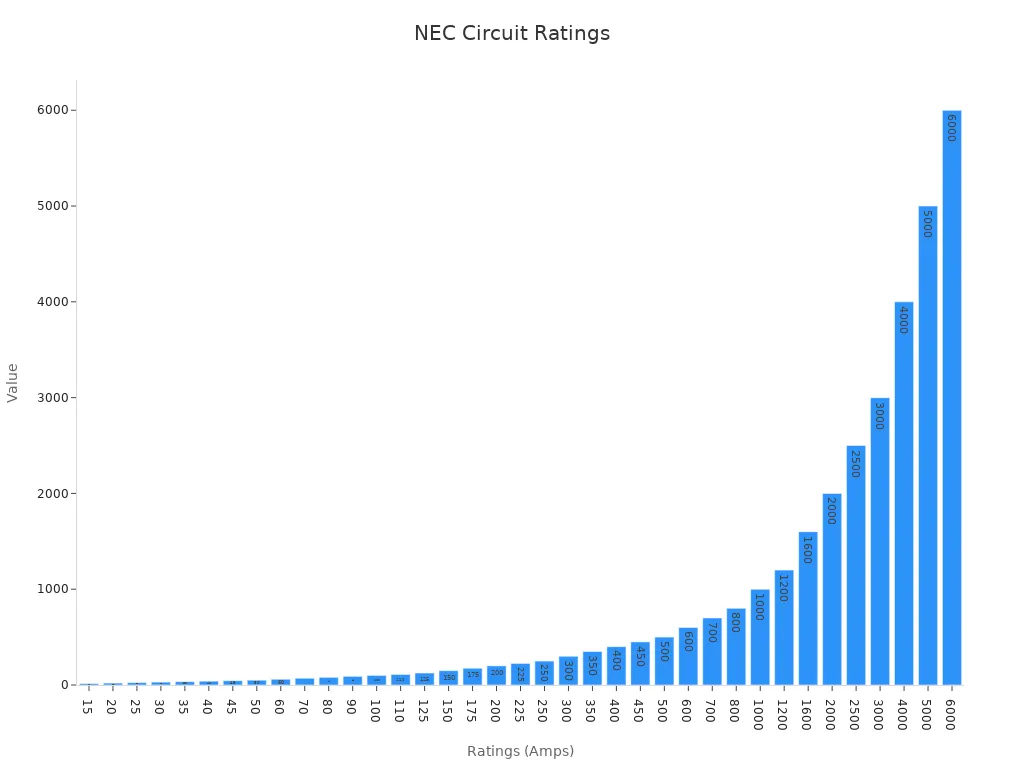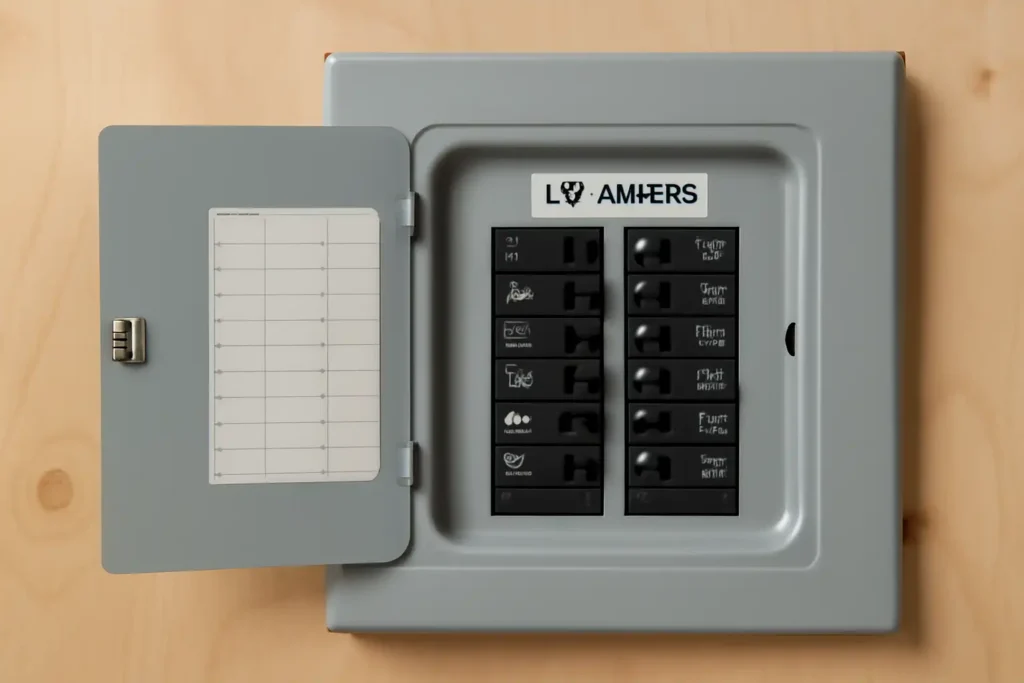You can usually operate 20 to 42 circuit breakers on a 100 amp panel. Most 100 amp panels have about 30 breaker slots, as shown in the table below. The actual number depends on the panel’s design, the type of breakers, and safety codes.
| Panel Feature | Example Quantity |
|---|---|
| Double-pole breakers | 5 |
| Single-pole breakers | 3 |
| Spare slots | 17 |
| Total slots | 30 |
The total of breaker ratings can add up to more than 100 amps. The main breaker limits the real load to 100 amps at any moment. Panel design, breaker type, and code rules all shape how many circuit breakers you can use safely.
Key Takeaways
- A 100 amp panel can have 20 to 42 circuit breakers. The number depends on how it is made and safety rules.
- Tandem breakers let you fit two breakers in one slot. You can only use them if your panel says it is okay.
- The main breaker stops the current at 100 amps. This keeps your home safe, even if the breakers add up to more.
- Always follow the National Electrical Code and what the maker says. This helps stop too many breakers and too much heat.
- If you need upgrades or have problems, call a licensed electrician. They will help keep your electrical system safe and working well.
Circuit Breakers and Panel Capacity

Breaker Slots
When you look inside a 100 amp panel, you see rows of slots for circuit breakers. Each slot holds one breaker, but not every panel has the same number of slots. Some panels have 20 slots, while others have 24, 32, or even 42. The number of slots tells you how many circuit breakers you can install, but the actual limit depends on more than just space.
Tip: Always check the label inside your panel. It shows the maximum number of circuit breakers and the types you can use.
The National Electrical Code (NEC) and manufacturers set rules for breaker slots. Here is what you need to know:
- NEC 312.7 says you must not install more circuit breakers than the panel’s listed capacity.
- You must not overcrowd the panel. Wires need enough space to fit safely.
- Most panels should not run at more than 80% of their full rated capacity. This leaves room for future upgrades.
- You must seal any unused openings in the panel to keep it safe.
If you follow these rules, you keep your electrical system safe and ready for changes.
Tandem Breakers
Tandem breakers help you fit more circuits into a panel without adding more slots. These breakers hold two circuits in the space of one standard breaker. You use them when your panel is full, but you need more circuits for things like extra lights or outlets.
Manufacturers decide if you can use tandem breakers in your panel. Some panels allow them, while others do not. You must check your panel’s model number and the diagram inside the panel door. Here is a table that shows how different panels handle tandem breakers:
| Panel Model Example | Breaker Spaces | Total Circuits Allowed | Tandem Breaker Use Allowed? | Max Tandem Breakers Allowed |
|---|---|---|---|---|
| G3040BL1200 | 30 | 40 | Yes | Up to 10 |
| G3030BL1150 | 30 | 30 | No | N/A |
| BR1220B100 | 12 | 20 | Yes | Up to 8 |
| BR1212B100 | 12 | 12 | No | N/A |
| HOMC20U100C | 20 | 20 | No | N/A |
Tandem breakers give you a way to expand your panel’s circuit count. For example, a panel with 30 slots might allow up to 40 circuits if you use tandem breakers in the right places. This makes it easier to add new appliances or rooms without replacing the whole panel.
You must always follow the manufacturer’s instructions and the NEC rules when adding circuit breakers or using tandem breakers. This keeps your home safe and your electrical system working well.
Amperage Limits

Total Load vs. Breaker Ratings
When you look at a 100 amp panel, you might notice that the sum of all the circuit breakers’ ratings often adds up to more than 100 amps. This does not mean your panel is overloaded. The reason is that each breaker protects its own circuit, and not every circuit will draw its maximum current at the same time.
- Breaker ratings show the highest current each breaker can handle, not the actual current used.
- The total of all breaker ratings can be higher than the panel’s main rating because most circuits run at less than full power.
- The main breaker will trip if the total current in the panel goes over 100 amps, keeping your system safe.
- Each breaker protects its own wires and devices. If a circuit draws too much current, only that breaker will trip.
- The National Electrical Code (NEC) suggests using only 80% of the panel’s capacity for continuous loads, but short-term or intermittent loads can use up to 100%.
Note: You can safely have more breaker capacity than the panel’s main rating, as long as the total current drawn at one time does not go over 100 amps.
Here is a simple way to understand the difference between breaker ratings and actual load:
- Find the rating on each circuit breaker (usually 15 or 20 amps for homes).
- Multiply the breaker’s rating by 0.8 to get the safe continuous load (for a 15-amp breaker, that’s 12 amps).
- Add up the current used by all devices on the circuit.
- Make sure the total does not go over 80% of the breaker’s rating for long-term use.
You can use this method to check if your circuits are safely loaded.
Main Breaker Function
The main breaker acts as the guardian of your electrical panel. It limits the total amount of electricity that can flow through the panel at any time. Even if you have many circuit breakers, the main breaker will trip if the total current goes above 100 amps. This protects your home from overheating and fire hazards.
You can estimate your home’s total load using a simple method. Look at your electric meter and count the number of disk revolutions in one minute. Multiply this by the meter’s constant (Kh) to find the load in kilowatts. Then, divide by your home’s voltage (usually 240V) to get the total amperes. For example, if your meter has a Kh of 3.6 and you count 68 revolutions in one minute, your load is about 14.7 kW, or 61.2 amps. This shows you are well within the 100 amp limit.
Here is a table that shows how to size breakers and wires for different types of loads:
| Load Type | Maximum Breaker Size (% of Load Current) |
|---|---|
| Resistive Loads (heaters, stoves, water heaters) | 125% |
| Lighting Loads | 125% |
| Motors (hermetically sealed, AC, heat pumps) | 175% |
| Welders | 200% |
| Motor Circuit Protectors (MCP) | 125% or next larger size |
You should always make sure that the breaker size does not exceed the wire’s ampacity. Using a breaker that is too large can cause overheating and fire. Using a breaker that is too small can cause it to trip often.
Tip: Amps measure the flow of electricity, volts measure the pressure, and watts measure the power used. Knowing these helps you understand your panel’s limits.
You can have many circuit breakers in your panel, but the main breaker is the true limit. It keeps your home safe by stopping the flow if you try to use more than 100 amps at once.
Code and Safety
NEC Requirements
You need to follow the National Electrical Code (NEC) when working with a 100 amp panel. The NEC sets clear rules to keep your electrical system safe. One important rule is the 80% guideline for continuous loads. This means you should not use more than 80 amps on a 100 amp panel for long periods. This helps prevent overheating and keeps your panel working well.
The NEC also lists standard sizes for breakers. You can see that 100 amps is a common size for homes. Here is a table showing the standard breaker ratings:
| Standard Breaker Ratings (Amperes) |
|---|
| 15, 20, 25, 30, 35, 40, 45, 50, 60, 70, 80, 90, 100, 110, 125, 150, 175, 200, 225, 250, 300, 350, 400, 450, 500, 600, 700, 800, 1000, 1200, 1600, 2000, 2500, 3000, 4000, 5000, 6000 |
You can also see these ratings in the chart below:

You should always check your panel’s label and follow the NEC rules. This keeps your home safe and helps you avoid problems with insurance or inspections.
Manufacturer Guidelines
You must follow the manufacturer’s instructions when installing or replacing breakers in your panel. These steps help you avoid mistakes and keep your system safe:
- Check for safety by turning off all power and using lockout/tagout methods.
- Inspect the panel for damage, dirt, or tight spaces before you start.
- Make sure the breaker matches your panel and fits correctly.
- Prepare wires as the manufacturer says, including stripping them to the right length.
- Snap the breaker into place on the panel bus and listen for a click.
- Connect wires tightly and use the right torque (for 100A breakers, 35-50 in-lbs).
- Look for proper seating and make sure no wires touch the panel box.
- Put the cover back on and check that breaker handles move freely.
- Label each circuit clearly with its use.
- Test the panel by checking connections and using thermal imaging if possible.
- Avoid mixing wire types or using breakers as switches.
- Only let certified electricians work on your panel.
Tip: Always read the manufacturer’s label and instructions. If you are not sure, call a licensed electrician. This keeps you and your home safe.
Configurations
Sample Layouts
There are many safe ways to set up a 100 amp panel. Most panels have a main disconnect switch. They also have hot and neutral bus bars, plus a grounding bar. Branch circuits connect to the bus bars. Each circuit uses its own breaker. Circuits that do the same job are grouped together. For example, lights might be on one side and outlets on the other. This makes it easier to find and manage each circuit.
- Put the main breaker at the top or in the middle.
- Place branch breakers in order and group similar ones.
- Use special circuits for big appliances like ovens or dryers.
- Keep lights and outlets on different circuits for easy fixes.
- Connect each neutral and ground wire to the right bar.
A normal 100 amp panel has 20 to 30 slots. There is often a diagram inside the panel door. This diagram shows the best way to arrange breakers. Always follow this guide. It is important to keep neutral and ground wires separate and bonded right. Many wiring diagrams show these steps in order.
Good layouts stop overloads and help with upgrades later. Labeling each breaker helps you know what it controls.
Common Mistakes
Some mistakes can make your panel unsafe or cause breakers to trip. Try not to make these errors:
- Putting too many breakers in the panel.
- Placing high-load breakers next to each other, which can cause heat.
- Using shared neutrals for single-phase circuits, which can be dangerous.
- Not grounding and bonding the panel the right way.
- Not tightening wire ends, which can cause loose wires and heat.
Case studies show that bad breaker placement can cause overheating and tripping. You should spread out the load on both phases. Do not share neutrals between circuits. Always check that your panel follows the rules and the manufacturer’s instructions.
Tip: Check your panel often. Tighten connections and look for heat to keep it safe.
Most 100 amp panels can hold 20 to 42 breakers. The real number depends on how your panel is made and what the rules say. The manufacturer and the National Electrical Code set these rules. Always follow safety rules when working with your panel. Do not put in more breakers than your panel is made for. Do not use more power than the main breaker allows. If you want to upgrade your panel or are not sure about its size, ask a licensed electrician for help.
FAQ
What happens if you install too many breakers in a 100 amp panel?
If you install too many breakers, you risk overcrowding the panel. This can cause overheating and safety hazards. Always follow the panel’s label and the manufacturer’s instructions.
What is a tandem breaker and when can you use one?
A tandem breaker fits two circuits into one slot. You can use one only if your panel allows it. Check the diagram inside your panel door before installing a tandem breaker.
What should you do if your panel trips often?
Frequent tripping means your circuits may be overloaded. You should unplug some devices and check for problems. If tripping continues, call a licensed electrician for help.
What is the difference between breaker slots and circuits?
Breaker slots are spaces in your panel for breakers. Circuits are the electrical paths each breaker controls. Some slots can hold tandem breakers, which increases the number of circuits.
What is the safest way to upgrade a 100 amp panel?
You should always hire a licensed electrician for upgrades. The electrician will check your home’s needs and follow all codes. Never try to upgrade the panel yourself.
The following information may be of interest to you
Can I put two circuits on one circuit breaker
How many watts can a 20 ampere circuit breaker handle
How to choose the appropriate size of circuit breaker
How to Calculate the Number of 20 Amp Breakers in a 100 Amp Panel



